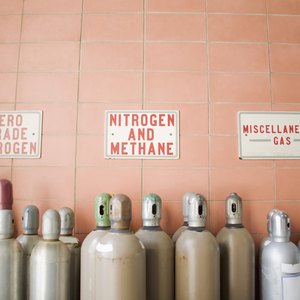
Cylinders are three-dimensional containers that are typically used to store compressed gas, pressurized liquid and other similar hazardous contents. Transporting cylinders requires great care, owing to the high risk associated with their contents. Strict rules apply when these cylinders are to be transported to ensure the safety of all involved. While the safest way to transport cylinders is vertically, large quantities of cylinders are still transported horizontally, posing a significant safety risk.
Cylinder Transport
Cylinders are routinely transported from point to point in special carriers, trolleys, derricks and cranes, rail wagons and trailers, conveyors, powered vehicles and ships, depending on the distance and cylinder contents. For example, trucking is the most common way to transport compressed hydrogen cylinders and carts are used to move LPG cylinders within the same vicinity. Using and transporting cylinders is generally safe. However, there is potential for serious accidents if cylinders are not safely handled.
Risks Associated with Horizontally Transporting Cylinders
Contents of cylinders can pose considerable risk to human life. This risk is augmented when cylinders are transported horizontally. Products such as nitrogen can cause asphyxiation while oxygen can cause fires. Acetylene is a highly flammable gas used for cutting, brazing and welding metals and steel. Cylinders containing acetylene must always be kept and transported in an upright position, preferably in vertical racks, according to the Occupational Safety and Health Administration (OSHA). Horizontally transporting acetylene cylinders may cause the gas within the container to become unstable and cause an explosion.
Precautions
Liquefied and compressed gas cylinders must never be transported horizontally.
Cylinders carrying flammable substances, such as IPG, hydrogen gas and ethylene, which are explosive and flammable risks, must only be stored and transported vertically. Inert gas and refrigerated liquid cylinders, such as those carrying argon and nitrogen, are liable to leak if placed horizontally, causing drowsiness, asphyxiation, unconsciousness and even death.
Cylinders carrying toxic substances, such as sulphur dioxide, must only be transported vertically.
It is safe to transport certain medical gas cylinders horizontally. Rounded bottom cylinders and smaller cylinders can be transported horizontally, provided they are secured in horizontally adjustable cylinder brackets.
Cylinders must only be handled and transported by properly equipped, trained and qualified personnel. Cylinder contents must be clearly stated on surface labels.
Recommendations
The safest way to transport cylinders is by hiring a professional transport company. If cylinders are to be transported in-house, it is imperative that all be secured during transport. Trailers or open vehicles are recommended over enclosed vehicles. Great care should be taken never to drop a cylinder or submit it to shock. Trolleys and mechanical lifting devices are preferred over handing and manually lifting cylinders. Flammable and toxic gases must never be transported horizontally or in enclosed vehicles.
References
Writer Bio
Natasha Gilani has been a writer since 2004, with work appearing in various online publications. She is also a member of the Canadian Writers Association. Gilani holds a Master of Business Administration in finance and an honors Bachelor of Science in information technology from the University of Peshawar, Pakistan.

